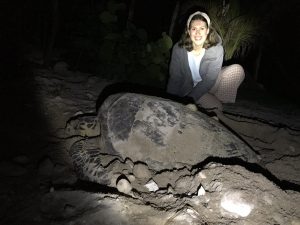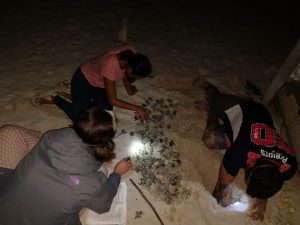An Exemplary Model for Small Groups Looking to Get Things Done
I have volunteered with a number of organizations in the past and you get all sorts from the big ‘corporates’ to the small one-(wo)man- bands fighting for or against whatever is pressing in a particular place – plastics, a particular species, human rights – the whole gamut. So when I decided last summer to go and join a small team of environmental activists and one biologist working to protect the Hawksbill Sea Turtle, on the coast of Campeche in Mexico, all I really knew was that there were turtles involved – the rest I knew was a big unknown, no matter how much I tried to find out ahead of time.
The Hawksbill is currently registered as critically endangered, facing possible extinction from numerous threats, both directly and indirectly anthropogenic in nature. I soon realised that this conservation program I had jumped into had in evidence what are probably the full range of existential threats currently faced by all sea turtles.
CLICK TO LEARN ABOUT THE CAMPECHE TURTLE PROJECT
The biologist is Luis Antonio Góngora Dominguez, and his non-profit Yuumtsil Káak Náab A.C., which alongside the help of a local NGO, Ninth Wave Global, weave an uneasy path through the presence of stray dogs, plastic waste, litter, port lights, illegal builds – I could go on and add to this already extensive list of dangers. But somehow, gradually, I started to realise how unique this largely unsupported project and collaboration is, and how it is an exemplary model to follow for small groups looking to get things done.
A normal evening during turtle nesting season begins with a patrol between 9 and 10pm. After stringing up our hammocks under a palapa, we await the arrival of Luis, usually on his quad bike, to make the first rounds of the beach for potential tracks or traces of nesting females.
READ THE SPANISH VERSION OF THIS BLOG POST
His unconventional style resonates in his practice, using only sticks, his memory and – cunningly because he knows nobody pays it any attention – existing plastic waste on the beach to help mark new nests for future reference. No technology and minimal support, just unwavering enthusiasm and a commitment to nature.
After Luis’ careful guidance, we are left to carry out 3am patrols alone, sitting patiently with any turtles upon arriving on the beach, to when they have patted down their nest and crawl back to sea. A process that can take up to two hours, but nevertheless a privilege to see.
Yet, it is Luis’ knowledge and dedication in protecting and monitoring the nests that I valued the most. Each nest is monitored daily over the 60-day period, and to my disbelief, the timeframe of each nest is estimated by testing the density of the sand with just a stick.
This precision was undeniable when reaching nests within hours of hatchlings clambering to the surface, to freeing those trapped in plastic rubble or mistakenly following port lights as they emerged from the sand, never leaving a turtle behind. Despite their numbers, the odds of surviving to sexual maturity are stacked against them, underlining the importance of small conservation efforts like this one.
I was also surprised to learn that nests of inexperienced, younger females can be frequently detected further down the beach or in problematic locations, often the case at Payucan beach due to littering and human activity. However, like in everything he does, Luis takes a measured and cautious approach, crafting incubators out of old polystyrene boxes and wet sand and tending to these vulnerable nests at his home.
His method of encouraging the involvement of volunteers, entrusting us with delicate tasks such as moving eggs to incubate or marking nests and safeguarding turtles on patrols, was an invaluable part of my experience. Watching the lengths that Luis goes in protecting this species for future generations and inspiring others, in ways both unfounded and personal, is humbling.
Meanwhile, in the current climate, with many success stories circulating the globe of sea turtles revisiting old nesting grounds, it is the hope of Luis and his volunteers that such triumphs will be echoed on the beaches of Campeche. Offering much sought after breathing space for the Hawksbill species before local tourists flock back to the beaches and returning to the old ‘normal’.
Rhona Macdonald worked with Ninth Wave Mexico and Yuumtsil Káak Náab A.C. in the summer of 2019. She is currently completing her MSc in Sustainability and Environmental Studies at the University of Strathclyde in Scotland and will be returning to join the team in Mexico again as soon as the pandemic allows.


